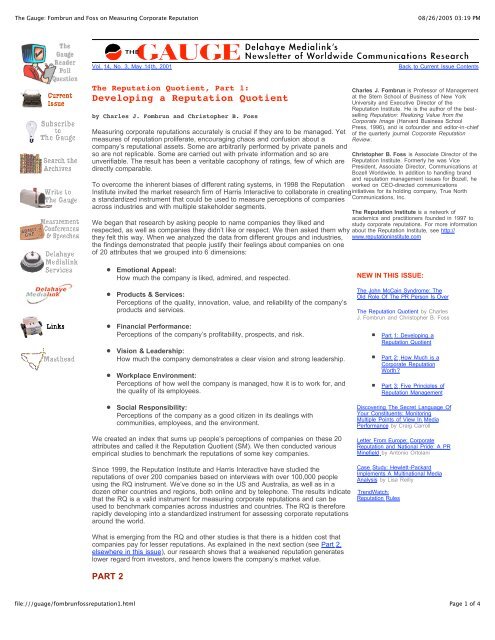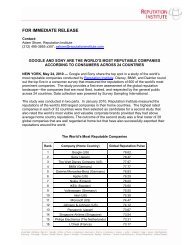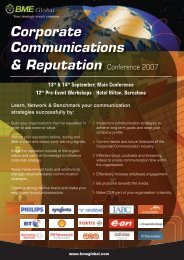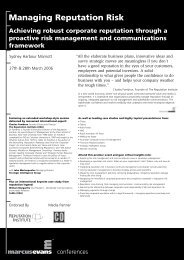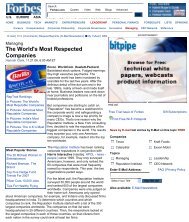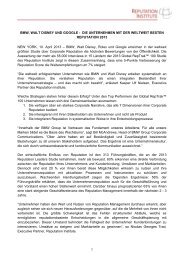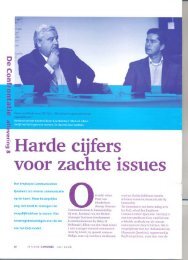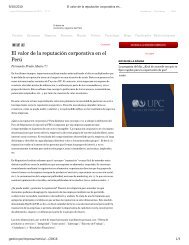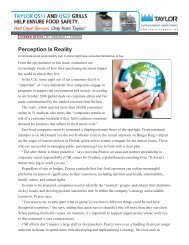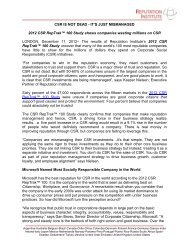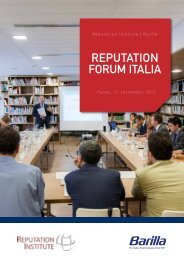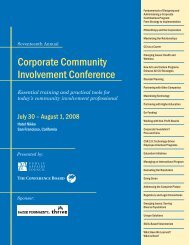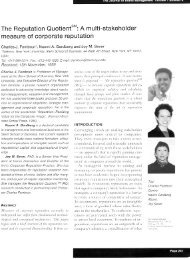The Reputation Quotient - Reputation Institute
The Reputation Quotient - Reputation Institute
The Reputation Quotient - Reputation Institute
You also want an ePaper? Increase the reach of your titles
YUMPU automatically turns print PDFs into web optimized ePapers that Google loves.
<strong>The</strong> Gauge: Fombrun and Foss on Measuring Corporate <strong>Reputation</strong><br />
08/26/2005 03:19 PM<br />
Vol. 14, No. 3, May 14th, 2001<br />
Back to Current Issue Contents<br />
<strong>The</strong> <strong>Reputation</strong> <strong>Quotient</strong>, Part 1:<br />
Developing a <strong>Reputation</strong> <strong>Quotient</strong><br />
by Charles J. Fombrun and Christopher B. Foss<br />
Measuring corporate reputations accurately is crucial if they are to be managed. Yet<br />
measures of reputation proliferate, encouraging chaos and confusion about a<br />
company’s reputational assets. Some are arbitrarily performed by private panels and<br />
so are not replicable. Some are carried out with private information and so are<br />
unverifiable. <strong>The</strong> result has been a veritable cacophony of ratings, few of which are<br />
directly comparable.<br />
To overcome the inherent biases of different rating systems, in 1998 the <strong>Reputation</strong><br />
<strong>Institute</strong> invited the market research firm of Harris Interactive to collaborate in creating<br />
a standardized instrument that could be used to measure perceptions of companies<br />
across industries and with multiple stakeholder segments.<br />
We began that research by asking people to name companies they liked and<br />
respected, as well as companies they didn’t like or respect. We then asked them why<br />
they felt this way. When we analyzed the data from different groups and industries,<br />
the findings demonstrated that people justify their feelings about companies on one<br />
of 20 attributes that we grouped into 6 dimensions:<br />
Charles J. Fombrun is Professor of Management<br />
at the Stern School of Business of New York<br />
University and Executive Director of the<br />
<strong>Reputation</strong> <strong>Institute</strong>. He is the author of the bestselling<br />
<strong>Reputation</strong>: Realizing Value from the<br />
Corporate Image (Harvard Business School<br />
Press, 1996), and is cofounder and editor-in-chief<br />
of the quarterly journal Corporate <strong>Reputation</strong><br />
Review.<br />
Christopher B. Foss is Associate Director of the<br />
<strong>Reputation</strong> <strong>Institute</strong>. Formerly he was Vice<br />
President, Associate Director, Communications at<br />
Bozell Worldwide. In addition to handling brand<br />
and reputation management issues for Bozell, he<br />
worked on CEO-directed communications<br />
initiatives for its holding company, True North<br />
Communications, Inc.<br />
<strong>The</strong> <strong>Reputation</strong> <strong>Institute</strong> is a network of<br />
academics and practitioners founded in 1997 to<br />
study corporate reputations. For more information<br />
about the <strong>Reputation</strong> <strong>Institute</strong>, see http://<br />
www.reputationinstitute.com<br />
Emotional Appeal:<br />
How much the company is liked, admired, and respected.<br />
Products & Services:<br />
Perceptions of the quality, innovation, value, and reliability of the company’s<br />
products and services.<br />
Financial Performance:<br />
Perceptions of the company’s profitability, prospects, and risk.<br />
Vision & Leadership:<br />
How much the company demonstrates a clear vision and strong leadership.<br />
Workplace Environment:<br />
Perceptions of how well the company is managed, how it is to work for, and<br />
the quality of its employees.<br />
Social Responsibility:<br />
Perceptions of the company as a good citizen in its dealings with<br />
communities, employees, and the environment.<br />
We created an index that sums up people’s perceptions of companies on these 20<br />
attributes and called it the <strong>Reputation</strong> <strong>Quotient</strong> (SM). We then conducted various<br />
empirical studies to benchmark the reputations of some key companies.<br />
NEW IN THIS ISSUE:<br />
<strong>The</strong> John McCain Syndrome: <strong>The</strong><br />
Old Role Of <strong>The</strong> PR Person Is Over<br />
<strong>The</strong> <strong>Reputation</strong> <strong>Quotient</strong> by Charles<br />
J. Fombrun and Christopher B. Foss<br />
Part 1: Developing a<br />
<strong>Reputation</strong> <strong>Quotient</strong><br />
Part 2: How Much is a<br />
Corporate <strong>Reputation</strong><br />
Worth?<br />
Part 3: Five Principles of<br />
<strong>Reputation</strong> Management<br />
Discovering <strong>The</strong> Secret Language Of<br />
Your Constituents: Monitoring<br />
Multiple Points of View In Media<br />
Performance by Craig Carroll<br />
Letter From Europe: Corporate<br />
<strong>Reputation</strong> and National Pride: A PR<br />
Minefield by Antonio Ortolani<br />
Since 1999, the <strong>Reputation</strong> <strong>Institute</strong> and Harris Interactive have studied the<br />
reputations of over 200 companies based on interviews with over 100,000 people<br />
using the RQ instrument. We’ve done so in the US and Australia, as well as in a<br />
dozen other countries and regions, both online and by telephone. <strong>The</strong> results indicate<br />
that the RQ is a valid instrument for measuring corporate reputations and can be<br />
used to benchmark companies across industries and countries. <strong>The</strong> RQ is therefore<br />
rapidly developing into a standardized instrument for assessing corporate reputations<br />
around the world.<br />
What is emerging from the RQ and other studies is that there is a hidden cost that<br />
companies pay for lesser reputations. As explained in the next section (see Part 2,<br />
elsewhere in this issue), our research shows that a weakened reputation generates<br />
lower regard from investors, and hence lowers the company’s market value.<br />
PART 2<br />
Case Study: Hewlett-Packard<br />
Implements A Multinational Media<br />
Analysis by Lisa Reilly<br />
TrendWatch:<br />
<strong>Reputation</strong> Rules<br />
file:///guage/fombrunfossreputation1.html<br />
Page 1 of 4
<strong>The</strong> Gauge: Fombrun and Foss on Measuring Corporate <strong>Reputation</strong><br />
08/26/2005 03:19 PM<br />
Academic efforts to quantify the value of reputation confirm that there are large<br />
economic premiums associated with corporate reputations. For instance, a study<br />
conducted at the University of Texas at Austin compared ten groups of companies<br />
with similar levels of risk and return, but different average reputation scores. Results<br />
showed that a 60% difference in reputation score was associated with a 7%<br />
difference in market value. Since an average company in the study was valued at $3<br />
billion, that means a 1-point difference in reputation score (from 6 to 7 on a 10-point<br />
scale) would be worth an additional $53 million in market value.<br />
Another project conducted at the University of Kansas suggests that reputational<br />
capital may involve even higher returns. A team of professors examined the<br />
relationship between market value, book value, profitability, and reputation for all the<br />
firms rated in Fortune’s “most admired companies” survey between 1983 and 1997.<br />
<strong>The</strong>y concluded that a 1-point change in reputation was associated with an average<br />
of $500 million in market value.<br />
More recently, the <strong>Reputation</strong> <strong>Institute</strong> examined some 35 companies whose RQ<br />
scores we had measured with Harris Interactive in both 1999 and 2000. An analysis<br />
of the stock prices of these companies revealed that a strong relationship exists<br />
between a change in RQ and a change in a company’s market value. Specifically, a<br />
positive 1-point increase in the RQ was associated with higher average market values<br />
of some $147 million, while a 1-point decrease was associated with market values<br />
that were lower by about $5 billion. <strong>The</strong>se results suggest that a ‘value spiral’<br />
operates through which better-regarded companies attract more investors who bid up<br />
their market value and further improve their reputations.<br />
<strong>The</strong> good news is that research confirms that reputations are valuable assets,<br />
however intangible. <strong>The</strong> bad news is that the size of the effect is still in question. It’s<br />
a safe bet to conclude from these studies, however, that reputations are worth a lot<br />
more than companies are now spending to manage them.<br />
PART 3<br />
So far, there are five principles we’ve learned from the <strong>Reputation</strong> <strong>Institute</strong>’s<br />
measurement and analysis of corporate reputations (See Part 1 and Part 2 of this<br />
series elsewhere in this issue):<br />
1.<br />
<strong>The</strong> Principle of Distinctiveness<br />
Strong reputations result when companies own a distinctive position in the<br />
minds of resource-holders. Take Intel and AMD, the two titans of<br />
microprocessors in the semiconductor industry. Both offer products of<br />
comparable quality, speed, and power. Yet Intel dominates AMD in the minds<br />
of computer buyers and other observers. Why? Because Intel owes its<br />
reputation, not to the quality of its products, but to the “Intel Inside” campaign<br />
that virtually defined those products as essential components of quality and<br />
high-tech ingenuity “powering” the better computers. <strong>The</strong> campaign assured<br />
Intel’s reputation as the guarantor of excellence to the end user. In short,<br />
Intel made itself distinctive.<br />
2.<br />
<strong>The</strong> Principle of Focus<br />
Strong reputations result when companies focus their actions and<br />
communications around a single core theme. Consider Johnson & Johnson.<br />
<strong>The</strong> company ranks tops in public trust. This is no accident: trustworthiness is<br />
a focal point of all J&J’s communications. It is evident in advertisements that<br />
single-mindedly portray J&J as a nurturing and caring company, with babies<br />
and children invariably featured or mentioned (despite the fact that J&J’s<br />
baby products division represents less than 7% of the company’s portfolio).<br />
3.<br />
<strong>The</strong> Principle of Consistency<br />
Strong reputations result when companies are consistent in their actions and<br />
communications to all resource-holders. Our surveys suggest that betterregarded<br />
companies are more likely to orchestrate and integrate their<br />
initiatives cross-functionally. Companies with weaker reputations suffer from<br />
maintaining compartmentalized relationships with constituents.<br />
Yet fragmentation of initiatives and communications remains the norm. Siloed<br />
staffs in Community Relations (and often in remote foundations) manage<br />
relationships with local community groups; in Investor Relations with analysts;<br />
in Advertising Departments (and in remote ad agencies) counsel on product<br />
and corporate positioning; and in Human Resources typically manage<br />
employee communications. Centripetal forces virtually guarantee<br />
inconsistency in what is said and done with a company’s different<br />
file:///guage/fombrunfossreputation1.html<br />
Page 2 of 4
<strong>The</strong> Gauge: Fombrun and Foss on Measuring Corporate <strong>Reputation</strong><br />
08/26/2005 03:19 PM<br />
constituencies.<br />
4.<br />
<strong>The</strong> Principle of Identity<br />
Strong reputations result when companies act in ways that are consistent<br />
with espoused principles of identity. Spin is anathema to reputation-building,<br />
and in time all efforts to manipulate external images that rely purely on<br />
advertising and public relations fail when they are disconnected from the<br />
company’s identity.<br />
In 1996, Royal Dutch/Shell embarked on an ambitious effort to rebuild a<br />
corporate reputation that was torn apart by the media following the company’s<br />
mishandling of two major crises in 1995. <strong>The</strong> program it developed was<br />
rooted in a soul-searching process that required identifying the company’s<br />
business principles and “core purpose” — the authentic values it supports<br />
and the behaviors it is willing to endorse. Focus groups held around the world<br />
unearthed that Shell’s core purpose as defined by employees and leaders<br />
was about “Helping to Make the Future a Better Place,” and this has since<br />
become an anchor for many of the company’s internal communications.<br />
5.<br />
<strong>The</strong> Principle of Transparency<br />
Strong reputations result when companies are transparent in the way they<br />
conduct their affairs. Transparency requires communication —a lot of it. <strong>The</strong><br />
<strong>Reputation</strong> <strong>Institute</strong> recently contrasted the communications of a group of<br />
high-RQ companies against direct rivals with lower RQs. <strong>The</strong> findings support<br />
the idea that companies with stronger reputations are more visible across all<br />
media. <strong>The</strong>y disclose more information about themselves and are more<br />
willing to engage stakeholders in dialogue.<br />
<strong>The</strong> nature of the information they disclose and the exact impact of such<br />
information on corporate identity makes all the difference. Now, due to the<br />
joint efforts of the <strong>Reputation</strong> <strong>Institute</strong> and Delahaye Medialink in creating a<br />
powerful, automated survey instrument called Media <strong>Reputation</strong> Index®, the<br />
drivers of corporate reputation, as filtered by the media, can be precisely<br />
measured.<br />
Conclusion<br />
If competition is the motor of the market economy, reputation is the fuel that makes it<br />
run. Alan Greenspan, Chairman of the US Federal Reserve, put it this way in his<br />
commencement speech at Harvard University on June 10, 2000:<br />
“In today's world, where ideas are increasingly displacing the physical in the<br />
production of economic value, competition for reputation becomes a significant driving<br />
force, propelling our economy forward. Manufactured goods often can be evaluated<br />
before the completion of a transaction. Service providers, on the other hand, usually<br />
can offer only their reputations.”<br />
“<strong>Reputation</strong> management” is an emerging discipline whose central tenet is that strong<br />
reputations result from initiatives and messages that are in tune with the distinctive<br />
values and personality of a company, and which are meaningful to all company<br />
constituents and stakeholder groups. It suggests that the essence of reputationbuilding<br />
lies, not in posturing, spin doctoring, wordsmithing, or puffery — the<br />
characteristics that gave old line corporate communications a bad name. Rather, it<br />
presents reputation management as a source of competitive advantage —and<br />
nothing less than enlightened self-interest. ###<br />
Education is a<br />
progressive discovery<br />
of our own<br />
ignorance.<br />
-Will Durant<br />
file:///guage/fombrunfossreputation1.html<br />
Page 3 of 4
<strong>The</strong> Gauge: Fombrun and Foss on Measuring Corporate <strong>Reputation</strong><br />
08/26/2005 03:19 PM<br />
file:///guage/fombrunfossreputation1.html<br />
Page 4 of 4


